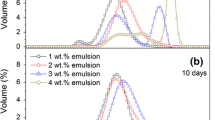Abstract
The compatibility and storage stability of styrene-butadiene-styrene copolymer (SBS) modified bitumens were studied using fluorescence microscopy and dynamic mechanical analysis. Chemical characteristics of base bitumens and SBS polymers were determined by means of thin layer and gel permeation chromatography, respectively. The results showed that the morphology and phase separation of the modified binders varied with the characteristics of bitumens and polymers and were influenced by polymer content. At a given polymer content, the modified binders produced from bitumens with a higher content of aromatics exhibited better compatibility and higher storage stability. An increase in asphaltenes was observed to adversely affect storage stability. When mixing a small amount of polymer with bitumen, the modified binder showed dispersed polymer particles. At relatively high polymer content, depending on the base bitumens used, a continuous SBS phase was observed. On the other hand, the storage stability of modified binders decreased with increasing SBS content. Compared with branched SBS polymer, linear SBS displayed a finer dispersion in modified binder, and consequently, a lower phase separation was observed during hot storage. The degree of SBS dispersion in bitumen influenced storage stability and the rheological properties of modified binders; however, no definite relationships among them could be established.
Résumé
La compatibilité et la stabilité au stockage des bitumes modifiés par des copolymères styrène-butadiène-styrène (SBS) ont été étudiées au moyen de la microscopie à fluorescence et de l'analyse rhéologique dynamique. Les caractéristiques chimiques des bitumes de base ont été déterminées par chromatographie en couche mince alors que celles des polymères SBS l'ont été par chromatographie à pennéation de gel. Les résultats ont montré que la morphologie et la séparation de phases des liants modifiés variaient sclon les caractéristiques des bitumes et des polymères et qu'elles étaient influencées par le contenu en polymères. Pour une teneur en polymères donnée, les liants modifiés à base de bitumes ayant un fort taux d'aromatiques ont montré une meilleure compatibilité et une plus grande stabilité au stockage. Il a été observé qu'une augmentation de la teneur en asphaltènes dégradait la stabilité au stockage. Pour des teneurs en polymère faibles, l'observation des liants modifiés montre des particules de polym``ere dispersées dans la phase bitume. À des teneurs relativement importantes en polymère, mais variables selon le bitume de base utilisé, on observe une phase polymère continue. Par contre, la stabilité au stockage des liants modifiés diminue lorsque la teneur en SBS augmente. En comparaison avec un polymère SBS de type radial (ramifié), le polymère SBS de type linéaire donne des dispersions plus fines qui se traduisent par une moindre tendance à la séparation de phases lors du stockage à chaud. Le degré de dispersion du polymère SBS dans le bitume influence à la fois la stabilité au stockage et les propriétés rhéologiques des liants modifiés. On n'a cependant pas pu établir de relations précises entre ces propriétés.
Similar content being viewed by others
References
Van Gooswilligen, G. and Vonk, W. C., ‘The role of bitumen in blends with thermoplastic rubbers for roofing applications’, Proceedings of VI International Conference “Roofing and Waterproofing”, International Waterproofing Association, London, 1986, 45–52.
Brûlé, B., ‘Les bitumes-polymères, notions de base’,Routes et Aérodromes, Dossier, Bitumes modifiés 711 (1) (October 1993) 18–22.
Madella, A., Le Bourlot, F. and Brûlé, B., ‘Selection of asphalt cements for asphalt cements/EVA blends’, Proceedings of the International Symposium on Chemistry of Bitumen, Vol. II, Rome, June 1991, 1000–1032.
Mancini, G., del Manso, F. and Bocchi, L., ‘Correlations between the chemical type of bitumen fractions and their interactions with SBS copolymers,’Ibid, 952–967.
Collins, J. H., Bouldin, M. G., Gelles, R. and Berker, A., ‘Improved performance of paving asphalts by polymer modification’,Proc. Assoc. of Asphalt Paving Technologists 60 (1991) 43–79.
Piazza, S., Arcozzi, A. and Verga, C., ‘Modified bitumens containing thermoplastic polymers’,Rubber Chemistry and Technology 53 (1980) 994–1005.
Bredael, P., Andriolo, P. and Killens, E., ‘A structural study of the hot storage stability of SBS-modified bitumens’, Proceedings of the International Symposium on Chemistry of Bitumen, Vol. II, Rome, June 1991, 932–951.
Choyce, P. and Woolley, K., ‘EVA modified binders’,Highways (January 1988) 18–21, 34.
Woolley, K.G., ‘Polymer modified bitumen for extra value asphalt’,Journal of the Institute of Asphalt Technology 38 (1986) 44–51.
Brûlé, B., Brion, Y. and Tanguy, A., ‘Paving asphalt polymer blends: relationships between composition, structure and properties’,Proc. Assoc. of Asphalt Paving Technologists 57 (1988) 41–64.
Bull, A. L. and Vonk, W. C., ‘Cariflex thermoplastic rubber: The living polymer’, Shell Bitumen Review 66, May 1992, 1–3.
Kraus, G., ‘Modification of asphalt by block polymers of butadiee and styrene’,Rubber Chemistry and Technology 55 (1982) 1389–1402.
Lu, X. and Isacsson, U., ‘Rheological characterization of styrene-butadiene-styrene block copolymer modified bitumens’,Construction and Building Materials 11 (1997) 23–32.
‘Cariflex TR in bitumens for road construction and maintenance’, Thermoplastic Rubbers Technical Manual TR 6.6, Shell Elastomers, 1987.
Isacsson, U. and Lu, X., ‘Testing and appraisal of polymer modified road bitumens—state of the art’,Mater. Struct. 28 (1995) 139–159.
Pfeiffer, J. Ph. and Saal, R. N. J., ‘Asphaltic bitumen as colloid system’,J. Phys. Chem. 44 (1940) 139–149.
Traxler, R. N. and Coombs, C. E., ‘The colloidal nature of asphalt as shown by its flow properties’,J. Phys. Chem. 40 (1936) 113–1147.
Mack, C. J., ‘Colloid chemistry of asphalts’,J. Phys. Chem. 36 (1932) 2901–2914.
Girdler, R. B., ‘Constitution of asphaltenes and related studies’,Proc. Assoc. of Asphalt Paving Technologists 34 (1965) 45–79.
Whitoeak, D., ‘The Shell Bitumen Handbook’, Shell Bitumen U.K., 1991, Chapter 6.
Valkering, C. P., Vonk, W. C. and Whiteoak, C. D., ‘Improved asphalt properties using SBS modified bitumens’, Shell Bitumen Review 66, May 1992, 9–11.
Author information
Authors and Affiliations
Additional information
Editorial note Mr. Ulf Isacsson is a RILEM Senior Member. He is a member of TC 152-PBM on Performance of Bituminous Materials.
Rights and permissions
About this article
Cite this article
Lu, X., Isacsson, U. Compatibility and storage stability of styrene-butadiene-styrene copolymer modified bitumens. Mat. Struct. 30, 618–626 (1997). https://doi.org/10.1007/BF02486904
Received:
Accepted:
Issue Date:
DOI: https://doi.org/10.1007/BF02486904




